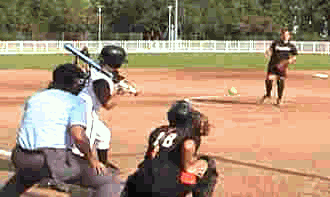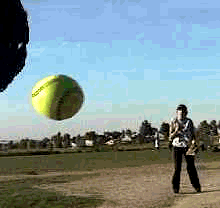|
by Gerald Warner, Softball Pitching
Instructor


Few softball
pitchers, even those with good speed, are able to overpower all
batters with their fastball. In time, sometimes as soon as the
second time through the line-up, some of the better hitters will be
able to time a fastball-only pitcher and start getting their bat on
the ball.
The
change-up
offers a change-of-speed alternative, but more importantly, it gives
a pitcher an exceptional psychological tool to keep batters
guessing.
Good hitting is a combination of swinging
on the right plane, with good bat speed, and with correct
timing.
Good pitching is a combination of
getting the batter to swing on the wrong plane and messing up her
timing.

MOST
TEENAGE PITCHERS throw their change-up too fast!
A
good deceptive change, with a decent fastball, can increase a
pitcher’s effectiveness by more than 50%.
When thrown with good
deception the change-up, thrown at 65% to
75% of the speed of the fastball, offers a
tremendous element of control over the batter.
(To make a change-up deceiving,
the start of the wind-up, the
pitcher's
facial expression and mannerisms, and arm
movement
need all need to look just like
those of the fastball).
With a change-up,
you put the batter on the defensive:
"What is she going to
throw to me this time?".
Now it is YOU, the
pitcher, who is in charge.
Unfortunately, some pitchers (and even a parent or coach) can quickly lose
confidence when a change-up misses its mark, or gets tagged for a
double. Something says, "She just hit the change-up," which
somehow gets interpreted as "THEY are hitting the change-up all the
time."
Nothing is more
disheartening or damaging to a pitcher with a decent change-up than
to hear her coach say, "Don't throw the change up any more".
"Just throw fastballs". "Just throw strikes". To restate
the highlighted statement two paragraphs above: Eliminating a
good deceptive change-up, and using only a decent fastball, can
decrease a pitcher's effectiveness by more than 50%.
Typically, we encourage a pitching student to
start working on a change-up after she has developed good pitching
mechanics, and can throw with relatively decent accuracy and good
speed. Depending on the learning ability this is usually 4 to
8 months after starting.
Then, the third pitch
we teach is usually a drop ball, but when first starting, we have it
thrown at a speed halfway between the speed of the fastball and the
change…therefore 80% to 90% of full speed. By starting work on
the drop ball at this slower speed, it increases the likelihood of
getting the spin started precisely at the release point. As
timing improves, we have the pitcher gradually increase the speed of
the drop.
SEE DETAILED INSTRUCTIONS for throwing any of
the basic CHANGE-UP styles in the article found elsewhere on this
website titled The Best
Change-Up
The article above can be downloaded and printed from
Microsoft Word

Do you want to reprint this
article or use it on your website or in your
newsletter?
As long as it is not for profit,
our only requirement is that you first notify us, then include the
following sentence:
Article by Gerald Warner of
PitchSoftball.com
and include a reference to this
website: www.pitchsoftball.com
If you have questions
or need more information
E-mail us, or call Pitching Instructor Gerald Warner in
Colorado at (720) 200-4575
Home Page | | About Us | E-Mail
Us
Other
Articles for 1st & 2nd Year
Pitchers | Beginning Pitchers | Advanced Pitchers | Coaches and
Parents | 





